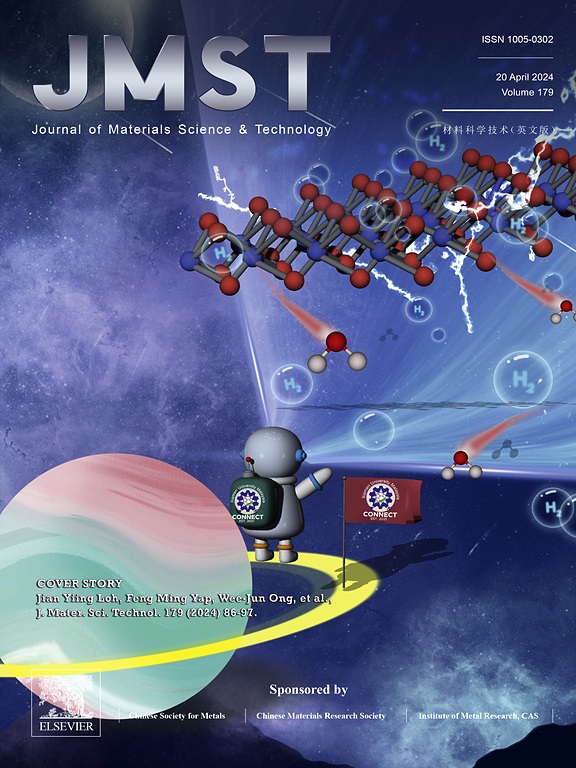一种三网聚乙烯醇/纤维素纳米纤维复合水凝胶,具有优异的强度、透明度、导电性和抗菌性能
IF 14.3
1区 材料科学
Q1 MATERIALS SCIENCE, MULTIDISCIPLINARY
引用次数: 0
摘要
聚乙烯醇(PVA)基水凝胶具有成本低、生物相容性好、凝胶化方法简单等优点,在组织工程、生物医学、柔性传感器等领域有着广泛的应用。反复的冻融循环对于制备这种水凝胶是必不可少的。虽然该工艺可以在一定程度上增强水凝胶的力学性能,但也会导致水凝胶不透明,拉伸性能有限,严重限制了其在可穿戴设备和电子皮肤中的应用。本研究将纤维素纳米纤维引入聚丙烯酰胺(PAM)/PVA双互穿网络水凝胶体系中,制备了具有“三网互锁”结构的多功能复合水凝胶。在多个网络、多个氢键和纳米增强的协同作用下,该复合水凝胶只需经过一次冻融循环就能达到超过1 MPa的抗拉强度,明显高于经过多次冻融循环的PVA水凝胶。在这项工作中制备的pva基水凝胶平衡了抗拉强度(1.41 MPa),伸长率(1332%),透明度(89.8%)和韧性(6.73 MJ m−³)。此外,该复合水凝胶具有高灵敏度(GF = 8.74),快速响应(108 ms),抗疲劳性和抗菌性能,使其成为宽应变范围内可靠的应变传感器。当封装在人体关节上时,它可以实时监测身体的运动,如手指、手腕、肘部和膝盖的运动,并可以集成到外围电路中,实现对机器人手的精确实时控制。这项工作提出了一种多功能复合水凝胶,作为组织工程、人机交互和高性能可穿戴传感器的候选材料具有很大的潜力。本文章由计算机程序翻译,如有差异,请以英文原文为准。

A triple-network PVA/cellulose nanofiber composite hydrogel with excellent strength, transparency, conductivity, and antibacterial properties
Polyvinyl alcohol (PVA)-based hydrogels are widely used in the fields of tissue engineering, biomedicine, and flexible sensors due to their low cost, excellent biocompatibility, and simple gelation methods. Repeated freeze-thaw cycles are essential for the preparation of such hydrogels. Although this process can enhance the mechanical properties of the hydrogels to a certain extent, it can also result in opacity and limited tensile performance, significantly restricting their application in wearable devices and electronic skin. This study introduced cellulose nanofibers into polyacrylamide (PAM)/PVA double interpenetrating network hydrogel system, achieving the preparation of a multifunctional composite hydrogel with a “triple-network interlock” structure. Under the synergistic effects of multiple networks, multiple hydrogen bonds, and nano-reinforcement, this composite hydrogel requires only a single freeze-thaw cycle to achieve a tensile strength exceeding 1 MPa, which is significantly higher than that of PVA hydrogels subjected to multiple freeze-thaw cycles. The PVA-based hydrogel prepared in this work balances tensile strength (1.41 MPa), elongation (1332%), transparency (89.8%), and toughness (6.73 MJ m−³). Additionally, this composite hydrogel exhibits high sensitivity (GF = 8.74), rapid response (108 ms), fatigue resistance, and antibacterial properties, making it a reliable strain sensor over a wide strain range. When encapsulated on human joints, it can monitor body movements in real-time, such as movements of fingers, wrists, elbows, and knees, and can be integrated into peripheral circuits to achieve precise real-time control of robotic hands. This work presents a multifunctional composite hydrogel with great potential as a candidate material for tissue engineering, human-machine interaction, and high-performance wearable sensors.
求助全文
通过发布文献求助,成功后即可免费获取论文全文。
去求助
来源期刊

Journal of Materials Science & Technology
工程技术-材料科学:综合
CiteScore
20.00
自引率
11.00%
发文量
995
审稿时长
13 days
期刊介绍:
Journal of Materials Science & Technology strives to promote global collaboration in the field of materials science and technology. It primarily publishes original research papers, invited review articles, letters, research notes, and summaries of scientific achievements. The journal covers a wide range of materials science and technology topics, including metallic materials, inorganic nonmetallic materials, and composite materials.
 求助内容:
求助内容: 应助结果提醒方式:
应助结果提醒方式:


